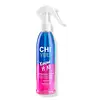What's inside
What's inside
 Key Ingredients
Key Ingredients

No key ingredients
 Benefits
Benefits

 Concerns
Concerns

 Ingredients Side-by-side
Ingredients Side-by-side

Water
Skin ConditioningIsohexadecane
EmollientIsododecane
EmollientDimethicone
EmollientPhenyl Trimethicone
Skin ConditioningAloe Barbadensis Leaf Juice
Skin ConditioningCamellia Sinensis Leaf Extract
AntimicrobialEchinacea Angustifolia Extract
MoisturisingEquisetum Arvense Extract
AstringentLavandula Angustifolia Flower/Leaf/Stem Extract
MaskingOcimum Basilicum Flower/Leaf Extract
TonicOlea Europaea Fruit Extract
BleachingPyrus Cydonia Seed Extract
MaskingRosmarinus Officinalis Leaf Extract
AntimicrobialSymphytum Officinale Rhizome/Root Extract
Skin ConditioningTrigonella Foenum-Graecum Seed Extract
PerfumingPolysilicone-15
UV FilterButeth-3
SolventSodium Benzotriazolyl Butylphenol Sulfonate
UV AbsorberPanthenol
Skin ConditioningPolysorbate 20
EmulsifyingTributyl Citrate
SolventPhenoxyethanol
PreservativeCaprylyl Glycol
EmollientHexylene Glycol
EmulsifyingEthylhexylglycerin
Skin ConditioningCitric Acid
BufferingParfum
MaskingBenzyl Benzoate
AntimicrobialBenzyl Salicylate
PerfumingCitronellol
PerfumingCoumarin
PerfumingLinalool
PerfumingCI 61565
Cosmetic ColorantCI 16035
Cosmetic ColorantCI 17200
Cosmetic ColorantWater, Isohexadecane, Isododecane, Dimethicone, Phenyl Trimethicone, Aloe Barbadensis Leaf Juice, Camellia Sinensis Leaf Extract, Echinacea Angustifolia Extract, Equisetum Arvense Extract, Lavandula Angustifolia Flower/Leaf/Stem Extract, Ocimum Basilicum Flower/Leaf Extract, Olea Europaea Fruit Extract, Pyrus Cydonia Seed Extract, Rosmarinus Officinalis Leaf Extract, Symphytum Officinale Rhizome/Root Extract, Trigonella Foenum-Graecum Seed Extract, Polysilicone-15, Buteth-3, Sodium Benzotriazolyl Butylphenol Sulfonate, Panthenol, Polysorbate 20, Tributyl Citrate, Phenoxyethanol, Caprylyl Glycol, Hexylene Glycol, Ethylhexylglycerin, Citric Acid, Parfum, Benzyl Benzoate, Benzyl Salicylate, Citronellol, Coumarin, Linalool, CI 61565, CI 16035, CI 17200
Crambe Abyssinica Seed Oil Phytosterol Esters
EmulsifyingHydrogenated Ethylhexyl Olivate
EmollientSaccharomyces Cerevisiae Extract
Skin ConditioningGlycerin
HumectantSqualane
EmollientHydrogenated Olive Oil Unsaponifiables
EmollientBrassica Oleracea Acephala Leaf Extract
HumectantCucurbita Pepo Seed Extract
Skin ConditioningLentinus Edodes Extract
Skin ConditioningOpuntia Tuna Fruit Extract
Skin ConditioningPsidium Guajava Fruit Extract
AstringentRibes Nigrum Fruit Extract
AstringentC20-22 Alkyl Phosphate
EmulsifyingC20-22 Alcohols
Emulsion StabilisingPolysorbate 60
EmulsifyingPolyester-11
Skin ConditioningHydroxyethyl Acrylate/Sodium Acryloyldimethyl Taurate Copolymer
Emulsion StabilisingEthylhexylglycerin
Skin ConditioningCitric Acid
BufferingDisodium EDTA
Leuconostoc/Radish Root Ferment Filtrate
AntimicrobialPotassium Sorbate
PreservativeAminomethyl Propanol
BufferingSodium Hydroxide
BufferingPhenoxyethanol
PreservativeSodium Benzoate
MaskingParfum
MaskingLinalool
PerfumingLimonene
PerfumingGeraniol
PerfumingCrambe Abyssinica Seed Oil Phytosterol Esters, Hydrogenated Ethylhexyl Olivate, Saccharomyces Cerevisiae Extract, Glycerin, Squalane, Hydrogenated Olive Oil Unsaponifiables, Brassica Oleracea Acephala Leaf Extract, Cucurbita Pepo Seed Extract, Lentinus Edodes Extract, Opuntia Tuna Fruit Extract, Psidium Guajava Fruit Extract, Ribes Nigrum Fruit Extract, C20-22 Alkyl Phosphate, C20-22 Alcohols, Polysorbate 60, Polyester-11, Hydroxyethyl Acrylate/Sodium Acryloyldimethyl Taurate Copolymer, Ethylhexylglycerin, Citric Acid, Disodium EDTA, Leuconostoc/Radish Root Ferment Filtrate, Potassium Sorbate, Aminomethyl Propanol, Sodium Hydroxide, Phenoxyethanol, Sodium Benzoate, Parfum, Linalool, Limonene, Geraniol
Alternatives
Ingredients Explained
These ingredients are found in both products.
Ingredients higher up in an ingredient list are typically present in a larger amount.
Citric Acid is an alpha hydroxy acid (AHA) naturally found in citrus fruits like oranges, lemons, and limes.
Like other AHAs, citric acid can exfoliate skin by breaking down the bonds that hold dead skin cells together. This helps reveal smoother and brighter skin underneath.
However, this exfoliating effect only happens at high concentrations (20%) which can be hard to find in cosmetic products.
Due to this, citric acid is usually included in small amounts as a pH adjuster. This helps keep products slightly more acidic and compatible with skin's natural pH.
In skincare formulas, citric acid can:
While it can provide some skin benefits, research shows lactic acid and glycolic acid are generally more effective and less irritating exfoliants.
Most citric acid used in skincare today is made by fermenting sugars (usually from molasses). This synthetic version is identical to the natural citrus form but easier to stabilize and use in formulations.
Read more about some other popular AHA's here:
Learn more about Citric AcidEthylhexylglycerin (we can't pronounce this either) is commonly used as a preservative and skin softener. It is derived from glyceryl.
You might see Ethylhexylglycerin often paired with other preservatives such as phenoxyethanol. Ethylhexylglycerin has been found to increase the effectiveness of these other preservatives.
Linalool is a fragrance and helps add scent to products. It's derived from common plants such as cinnamon, mint, citrus, and lavender.
Like Limonene, this ingredient oxidizes when exposed to air. Oxidized linalool can cause allergies and skin sensitivity.
This ingredient has a scent that is floral, spicy tropical, and citrus-like.
Learn more about LinaloolParfum is a catch-all term for an ingredient or more that is used to give a scent to products.
Also called "fragrance", this ingredient can be a blend of hundreds of chemicals or plant oils. This means every product with "fragrance" or "parfum" in the ingredients list is a different mixture.
For instance, Habanolide is a proprietary trade name for a specific aroma chemical. When used as a fragrance ingredient in cosmetics, most aroma chemicals fall under the broad labeling category of “FRAGRANCE” or “PARFUM” according to EU and US regulations.
The term 'parfum' or 'fragrance' is not regulated in many countries. In many cases, it is up to the brand to define this term.
For instance, many brands choose to label themselves as "fragrance-free" because they are not using synthetic fragrances. However, their products may still contain ingredients such as essential oils that are considered a fragrance by INCI standards.
One example is Calendula flower extract. Calendula is an essential oil that still imparts a scent or 'fragrance'.
Depending on the blend, the ingredients in the mixture can cause allergies and sensitivities on the skin. Some ingredients that are known EU allergens include linalool and citronellol.
Parfum can also be used to mask or cover an unpleasant scent.
The bottom line is: not all fragrances/parfum/ingredients are created equally. If you are worried about fragrances, we recommend taking a closer look at an ingredient. And of course, we always recommend speaking with a professional.
Learn more about ParfumPhenoxyethanol is a preservative that has germicide, antimicrobial, and aromatic properties. Studies show that phenoxyethanol can prevent microbial growth. By itself, it has a scent that is similar to that of a rose.
It's often used in formulations along with Caprylyl Glycol to preserve the shelf life of products.